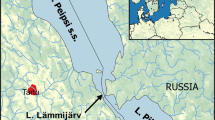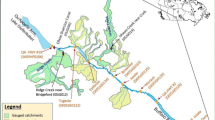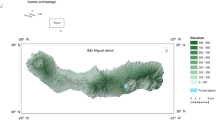Abstract
While expansion of agricultural land area and intensification of agricultural practices through irrigation and fertilizer use can bring many benefits to communities, intensifying land use also causes more contaminants, such as nutrients and pesticides, to enter rivers, lakes, and groundwater. For lakes such as Benmore in the Waitaki catchment, South Island, New Zealand, an area which is currently undergoing agricultural intensification, this could potentially lead to marked degradation of water clarity as well as effects on ecological, recreational, commercial, and tourism values. We undertook a modeling study to demonstrate science-based options for consideration of agricultural intensification in the catchment of Lake Benmore. Based on model simulations of a range of potential future nutrient loadings, it is clear that different areas within Lake Benmore may respond differently to increased nutrient loadings. A western arm (Ahuriri) could be most severely affected by land-use changes and associated increases in nutrient loadings. Lake-wide annual averages of an eutrophication indicator, the trophic level index (TLI) were derived from simulated chlorophyll a, total nitrogen, and total phosphorus concentrations. Results suggest that the lake will shift from oligotrophic (TLI = 2–3) to eutrophic (TLI = 4–5) as external loadings are increased eightfold over current baseline loads, corresponding to the potential land-use intensification in the catchment. This study provides a basis for use of model results in a decision-making process by outlining the environmental consequences of a series of land-use management options, and quantifying nutrient load limits needed to achieve defined trophic state objectives.






Similar content being viewed by others
References
Abbaspour KC, Yang J, Maximov I, Siber R, Bogner K, Mieleitner J, Zobrist J, Srinivasan R (2007) Modelling hydrology and water quality in the pre-alpine/alpine Thur watershed using SWAT. J Hydrol 333:413–430
Arhonditsis GB, Brett MT (2004) Evaluation of the current state of mechanistic aquatic biogeochemical modeling. Mar Ecol Prog Ser 271:13–26
Arhonditsis GB, Brett MT (2005a) Eutrophication model for Lake Washington (USA) Part I. Model description and sensitivity analysis. Ecol Model 187:140–178
Arhonditsis GB, Brett MT (2005b) Eutrophication model for Lake Washington (USA) Part II. Model calibration and system dynamics analysis. Ecol Model 187:179–200
Arhonditsis GB, Adams-VanHarn BA, Nielsen L, Stow CA, Reckhow KH (2006) Evaluation of the current state of mechanistic aquatic biogeochemical modelling: citation analysis and future perspectives. Environ Sci Technol 40:6547–6554
Brett MT, Benjamin MM (2008) A review and reassessment of lake phosphorus retention and the nutrient loading concept. Freshwat Biol 53:194–211
Burger DF, Hamilton DP, Pilditch CA (2008) Modelling the relative importance of internal and external nutrient loads on water column nutrient concentrations and phytoplankton biomass in a shallow polymictic lake. Ecol Model 211:411–423
Burns NM, Rutherford JC, Clayton JS (1999) A monitoring and classification system for New Zealand lakes and reservoirs. Lake Reserv Manag 15:255–271
Burns N, Bryers G, Bowman E (2000) Protocols for monitoring trophic levels of New Zealand lakes and reservoirs. Report prepared for Ministry for the Environment, Wellington
Chapra SC (1997) Surface water-quality modeling. McGraw-Hill, New York, p 844
Clark DA, Caradus JR, Monaghan RM, Sharp P, Thorrold BS (2007) Issues and options for future dairy farming in New Zealand. N Z J Agr Res 50:203–221
FAO (2010) Food price indices. Food and Agricultural Organisation of the United Nations. http://www.fao.org/worldfoodsituation/FoodPricesIndex/en/. Accessed 16 June 2014
Gal G, Hipsey MR, Parparov A, Wagner U, Makler V, Zohary T (2009) Implementation of ecological modeling as an effective management and investigation tool: lake Kinneret as a case study. Ecol Model 220:1697–1718
Gallegos CL, Davies-Colley RJ, Gall M (2008) Optical closure in lakes with contrasting extremes of reflectance. Limnol Oceanogr 53:2021–2034
Goward SN, Markham B, Dye DG, Dulaney W, Yang J (1991) Normalized difference vegetation index measurements from the Advanced Very High Resolution Radiometer. Remote Sens Environ 35:257–277
Graynoth E, Bennett LC, Pollard JC (1986) Diet of landlocked sockeye salmon (Oncorhynchus nerka) and trout in the Waitaki lakes, New Zealand. N Z J Mar Freshw Res 20:537–549
Green SR (2005) Potential for nitrate leaching under irrigation development in the Upper Waitaki catchment. Research Report commissioned by HortResearch and Glasson Potts Fowler. HortResearch Client Report No. 13650/2005, HortResearch, Palmerston North
Grizzetti B, Bouraoui F, Granlund K, Rekolainen S, Bidoglio G (2003) Modelling diffuse emission and retention of nutrients in the Vantaanjoki watershed (Finland) using the SWAT model. Ecol Model 169:25–38
Hamilton DP (2005) Land use impacts on nutrient export in the Central Volcanic Plateau, North Island. N Z J For 49:27–31
Hamilton DP, Landman M (2011) Preface: lake restoration: an experimental ecosystem approach for eutrophication control. Hydrobiologia 661:1–3
Hamilton DP, O’Brien KR, Burford MA, Brookes JD, McBride CG (2010) Vertical distributions of chlorophyll in deep, warm monomictic lakes. Aquat Sci 72:295–307
Hodges BR, Imberger J, Saggio A, Winters KB (2000) Modeling basin-scale internal waves in a stratified lake. Limnol Oceanogr 45:1603–1620
Irwin J (1981) Lake Benmore Bathymetry, 1:31177. New Zealand Oceanographic Institute Chart, Lake Series. Wellington
Jørgensen SE (1995) State of the art of ecological modeling in limnology. Ecol Model 78:101–115
Larned S, Schallenberg M (2006) Constraints on phytoplankton production in Lake Ellesmere/Te Waihora. NIWA Client Report: CHC2006-101, July 2006, NIWA Project: ENC05514. National Institute of Water & Atmospheric Research Ltd. Christchurch
Laval B, Imberger J, Hodges BR, Stocker R (2003) Modeling circulation in lakes: spatial and temporal variations. Limnol Oceanogr 48:983–994
MacLeod CJ, Moller H (2006) Intensification and diversification of New Zealand agriculture since 1960: an evaluation of current indicators of land use change. Agric Ecosyst Environ 115:201–218
McCarter NH (1986) Food and energy in the diet of brown and rainbow trout from Lake Benmore, New Zealand. N Z J Mar Freshw Res 20:551–559
McDowell RW (2004) Estimation of phosphorus loads from zones within the Upper Waitaki basin. Client Report prepared for Glasson Potts Fowler. AgResearch Ltd., Invermay Agricultural Centre, Mosgiel
Meredith AS, Wilks T (2006) Canterbury high country lakes water quality monitoring programme: results of 2006 monitoring and assessment of nutrient indices. Environment Canterbury Technical Report U06/34
Ministry for the Environment (2009) Water quality in selected dairy farming catchments: a baseline to support future water-quality trend assessments. Ministry for the Environment, Wellington, p 99
Ministry for the Environment (2010) Lake water quality in New Zealand 2010: status and trends. Report prepared for the Ministry for the Environment by the National Institute of Water and Atmospheric Research Ltd.
Ministry for the Environment (2013) Freshwater reform 2013 and beyond. Wellington: Ministry for the Environment, March 2013. http://www.mfe.govt.nz/publications/water/freshwater-reform-2013/freshwater-reform-2013.pdf. Accessed 16 June 2014
Missaghi S, Hondzo M (2010) Evaluation and application of a three-dimensional water quality model in a shallow lake with complex morphometry. Ecol Model 221:1512–1525
Mooij WM, Trolle D, Jeppesen E, Arhonditsis G, Belolipetsky PV, Chitamwebwa DBR, Degermendzhy AG, DeAngelis DL, De Senerpont Domis LN, Downing AS, Elliott JA, Fragoso CR Jr, Gaedke U, Genova SN, Gulati RD, Håkanson L, Hamilton DP, Hipsey MR, Hoen J, Hülsmann S, Los FJ, Makler-Pick V, Petzoldt T, Prokopkin IG, Rinke K, Schep SA, Tominaga K, Van Dam AA, Van Nes EH, Wells SA, Janse JH (2010) Challenges and opportunities for integrating lake ecosystem modelling approaches. Aquat Ecol 44:633–667
New Zealand Dairy Research Institute (2001) Catchment update. Quaterly newsletter by New Zealand Dairy Research Institute, Palmerston North
New Zealand Government (2011) National policy statement, freshwater management. Issued by notice in the Gazette on 12 May 2011. http://www.mfe.govt.nz/publications/rma/nps-freshwater-management-2011/docs/nps-freshwater-mgnt-2011.pdf. Accessed 16 June 2014
North EW, King DM, Xu J, Hood RR, Newell RI, Paynter K, Kellogg ML, Liddel MK, Boesch DF (2010) Linking optimization and ecological models in a decision support tool for oyster restoration and management. Ecol Appl 20:851–866
Parliamentary Commissioner for the Environment (2004) Growing for good: intensive farming, sustainability and New Zealand’s environment. Parliamentary Commissioner for the Environment, Wellington 236 p
Pickrill RA, Irwin J (1986) Circulation and sedimentation in Lake Benmore, New Zealand. N Z J Geol Geophys 29:83–97
Robson BJ, Hamilton DP (2004) Three-dimensional modelling of a Microcystis bloom event in the Swan River estuary, Western Australia. Ecol Model 174:203–222
Robson BJ, Hamilton DP, Webster IT, Chan T (2008) Ten steps applied to development and evaluation of complex biogeochemical models of estuaries. Environ Model Softw 23:369–384
Romero JR, Antenucci JP, Imberger J (2004) One- and three-dimensional biogeochemical simulations of two differing reservoirs. Ecol Model 174:143–160
Rueda FJ, Schladow SG, Clark JF (2008) Mechanisms of contaminant transport in a multi-basin lake. Ecol Appl 18:72–88
Schallenberg M, Burns CW (1999) Does zooplankton grazing affect seston size-structure and aerial hypolimnetic oxygen depletion in lakes? Arch Hydrobiol 147:1–24
Schallenberg M, Sorrell B (2009) Regime shifts between clear and turbid water in New Zealand lakes: environmental correlates and implications for management and restoration. N Z J Mar Freshw Res 43:701–712
Schipper LA, Baisden WT, Parfitt RL, Ross C, Claydon JJ, Arnold G (2007) Large losses of soil C and N from soil profiles under pasture in New Zealand during the past 20 years. Global Change Biol 13:1138–1144
Schoumans O, Silgram M, Walvoort D, Groenendijk P, Bouraoui F, Andersen HE, Porto AL, Reisser H, Le Gall G, Anthony S (2009) Evaluation of the difference of eight model applications to assess diffuse annual nutrient losses from agricultural land. J Environ Monit 11:540–553
Snelder T, Spigel B, Sutherland D, Norton N (2005) Assessment of effects of increased nutrient concentrations in streams and lakes of the Upper Waitaki Basin due to catchment land use changes. Prepared for Glasson Potts Fowler Ltd. NIWA Client Report CHC2005-003, NIWA Project GPF05501. National Institute of Water & Atmospheric Research Ltd., Christchurch
Speight JG (1963) Late Pleistocene historic geomorphology of the Lake Pukaki Area, New Zealand. N Z J Geol Geophys 6:160–188
Spillman CM, Hamilton DP, Imberger J (2009) Management strategies to optimise sustainable clam (Tapes philippinarum) harvests in Barbamarco Lagoon, Italy. Estuar Coast Shelf Sci 81:267–278
Stow C, Reckhow KH, Qian SS, Lamon EC, Arhonditsis GB, Borsuk ME, Seo D (2007) Approaches to evaluate water quality model parameter uncertainty for adaptive TMDL management. J Am Water Resour Assoc 43:1499–1507
Tilman D, Fargione J, Wolff B, D’Antonio C, Dobson A, Howarth R, Schindler D, Schlesinger WH, Simberloff D, Swackhamer D (2001) Forecasting agriculturally driven global environmental change. Science 292:281–284
Trolle D (2009) The influence of sediment nutrient dynamics on the response of lake ecosystems to restoration and climate change. Ph.D. Thesis, University of Waikato
Trolle D, Skovgaard H, Jeppesen E (2008a) The water framework directive: setting the phosphorus loading target for a deep lake in Denmark using the 1D lake ecosystem model DYRESM–CAEDYM. Ecol Model 219:138–152
Trolle D, Jørgensen TB, Jeppesen E (2008b) Predicting the effects of reduced external nitrogen loading on the nitrogen dynamics and ecological state of deep Lake Ravn, Denmark, using the DYRESM–CAEDYM model. Limnologica 38:220–232
Trolle D, Hamilton DP, Pilditch CA, Duggan IC, Jeppesen E (2011) Predicting the effects of climate change on trophic status of three morphologically varying lakes: implications for lake restoration and management. Environ Model Softw 26:354–370
Trolle D, Hamilton DP, Hipsey MR, Bolding K, Bruggeman J, Mooij WM, Janse JH, Nielsen A, Jeppesen E, Elliott A, Makler-Pick V, Petzoldt T, Rinke K, Flindt MR, Arhonditsis GB, Gal G, Bjerring R, Tominaga K, Hoen J, Downing AS, Marques DM, Fragoso CR, Søndergaard M, Hanson PC (2012) A community-based framework for aquatic ecosystem models. Hydrobiologia 683:25–34
Vant WN (1987) Lake managers handbook. Published for the National Water and Soil Conservation Authority by the Water and Soil Directorate, Ministry of Works and Development, Wellington
Vincent W, Gibbs MM, Dryden SJ (1984) Accelerated eutrophication in a New Zealand lake: lake Rotoiti, central North Island. N Z J Mar Freshw Res 18:431–440
Vollenweider RA (1976) Advances in defining critical loading levels for phosphorus in lake eutrophication. Mem Ist Ital Idrobiol 33:53–83
von Westernhagen N, Hamilton DP, Pilditch CA (2010) Temporal and spatial variations in phytoplankton productivity in surface waters of a warm-temperate, monomictic lake in New Zealand. Hydrobiologia 652:57–70
Walker S, Lee WG (2002) Alluvial grasslands of Canterbury and Marlborough, eastern South Island, New Zealand: vegetation patterns and long-term change. J R Soc N Z 32:113–147
White PA, Reeves RR, Barrell D, Smith M (2004) Groundwater in the Upper Waitaki catchment. DRAFT of Confidential Client Report 2004/115 prepared for Glasson Fowler Potts by the Institute of Geological and Nuclear Sciences, July 2004
Wilcock RJ (2008) Land-water interactions: impacts on the aquatic environment. In: McDowell RJ (ed) Environmental impacts of pasture-based farming. CAB International, Wallingford
Woods R, Elliott S, Shankar U, Bidwell V, Harris S, Wheeler D, Clothier B, Green S, Hewitt A, Gibb R, Parfitt R (2006) The CLUES Project: predicting the effects of land-use on water quality—Stage II. National Institute of Water and Atmospheric Research, Hamilton, New Zealand. NIWA Client Report HAM 2006-096, prepared for Ministry of Agriculture and Forestry
Acknowledgments
Funding support was provided by Environment Canterbury. Meridian Energy Limited funded the lake monitoring program and supplied hydrological data; we thank Eddie Stead of Meridian Energy Limited for his assistance and advice with flow and lake-level data. Additional funding was provided by the New Zealand Foundation of Research, Science, and Technology for Lake Biodiversity Restoration (Contract UOWX0505) and Ministry for Science and Innovation “Cumulative Effects” research program (CO1X1005). DT was also supported by CLEAR (a “Villum Kann Rasmussen Centre of Excellence Project on lake restoration”), EU-REFRESH and CRES. The ELCOM–CAEDYM model was provided by the Centre for Water Research, The University of Western Australia. Finally, we thank Greg Kelly and Lindsay Hawke of NIWA for capable assistance in the field.
Author information
Authors and Affiliations
Corresponding author
Electronic supplementary material
Below is the link to the electronic supplementary material.
Rights and permissions
About this article
Cite this article
Trolle, D., Spigel, B., Hamilton, D.P. et al. Application of a Three-Dimensional Water Quality Model as a Decision Support Tool for the Management of Land-Use Changes in the Catchment of an Oligotrophic Lake. Environmental Management 54, 479–493 (2014). https://doi.org/10.1007/s00267-014-0306-y
Received:
Accepted:
Published:
Issue Date:
DOI: https://doi.org/10.1007/s00267-014-0306-y




